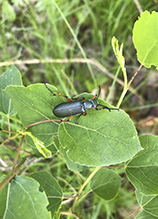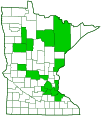Say blister beetle
(Lytta sayi)
Conservation • Description • Habitat • Ecology • Distribution • Taxonomy
|
|
||||||||||||||
Description |
Say blister beetle, sometimes called Say’s blister beetle, is an early season, medium-sized, blister beetle. It occurs in the northeastern United States and southeastern Canada from Nova Scotia to Maryland west to Ontario and Minnesota. An isolated population in Wyoming and South Dakota suggests that at one time in the distant past there was a westward expansion followed by a contraction to its current range. Adults are soft-bodied, elongated, and ½″ to ⅞″ (13 to 22 mm) in length. The population in the eastern United States and in Canada is mostly metallic greenish-blue, sometimes varying to bluish-green or pure green. The population in the Midwest, including Minnesota, is mostly pure bright green, often with a brassy sheen. The Wyoming population is dark bluish-green. The head is broad, triangular, and ant-like. It is very finely pitted, appearing satiny. The neck is short. The mouthparts are directed downwards. The upper lip (labrum) is notched, but the notch is not deep and does not extend to the middle. The antennae are bead-like and have eleven segments. The male has longer antennae than the female. Each antennal segment is slightly longer than wide. The exoskeletal plate covering the thorax (pronotum) is bell-shaped and about as wide as long. It is narrower than the head and narrower than the base of the wing covers (elytra). The elytra are soft, leathery, and essentially hairless. They are fully developed, covering most of the abdomen. The legs are long. The third segment (femur) is mostly orange, black just at the tip. On the male the femur is not contorted. The fourth segment (tibia) is also mostly orange, black just at the base and the tip. There is a pair of short spurs at the tip of each tibia. The last part of the leg (tarsus), corresponding to the foot, is black. The tarsi on the front and middle legs each have five segments, while those on the hind legs have only four segments. There is a pair of claws at the end of each tarsus. |
Size |
½″ to ⅞″ (13 to 22 mm) long |
Similar Species |
Habitat |
|
Ecology |
Season |
Mid-May to late July, but few records after June |
Behavior |
|
Life Cycle |
|
Larva Food |
|
Adult Food |
Flowers of willow, rose, and locust |
Distribution |
||
|
Sources Bionomics, systematics and phylogeny of Lytta, a genus of blister beetles (Coleoptera: Meloidae). Selander, R.B. 1960. Illinois Biological Monographs, No. 28, University of Illinois, Urbana, IL. |
|
| 6/11/2024 | ||
Occurrence |
||
|
||
Taxonomy |
|
Order |
Coleoptera (Beetles) |
Suborder |
Polyphaga (Water, Rove, Scarab, Long-horned, Leaf, and Snout Beetles) |
Infraorder |
Cucujiformia |
Superfamily |
Tenebrionoidea (darkling beetles and allies) |
Family |
Meloidae (blister beetles) |
Subfamily |
Meloinae |
Tribe |
Lyttini |
Genus |
Lytta |
Subgenus |
Pomphopoea |
Subordinate Taxa |
|
|
|
Synonyms |
|
|
|
Common Names |
|
Say blister beetle Say’s blister beetle |
|
Glossary
Elytra
The hardened or leathery forewings of beetles used to protect the fragile hindwings, which are used for flying. Singular: elytron.
Femur
On insects and arachnids, the third, largest, most robust segment of the leg, coming immediately before the tibia. On humans, the thigh bone.
Labrum
The upper part of the mouth, sometimes considered the lower part of the face, corresponding to the upper lip, on an insect or crustacean.
Pronotum
The exoskeletal plate on the upper side of the first segment of the thorax of an insect.
Tarsus
On insects, the last two to five subdivisions of the leg, attached to the tibia; the foot. On spiders, the last segment of the leg. Plural: tarsi.
Tibia
The fourth segment of an insect leg, after the femur and before the tarsus (foot). The fifth segment of a spider leg or palp. Plural: tibiae.
Visitor Photos |
||
Share your photo of this insect. |
||
This button not working for you? |
||
Valerie |
||
 |
||
| This `little` guy bumped into me on June 2022. |
|
|
Diana |
||
 |
|
|
Brandon Carlsness |
||
 |
|
|
I’ve always been an outdoors guy and in 37 years never saw one of these in Minnesota. Are these new here? |
|
|
MinnesotaSeasons.com Photos |
||
|
||
|
||

Visitor Videos |
||
Share your video of this insect. |
||
This button not working for you? |
||
|
Other Videos |
||
GREEN BLISTER BEETLE mating pairs compete for top spot (Lytta sayi) |
About
Feb 13, 2016 Lytta sayi = GREEN BLISTER BEETLE. One pair wanted to get to the top of the flower, but the other was not letting them. |

Visitor Sightings |
||
Report a sighting of this insect. |
||
This button not working for you? |
||
Blonde Mommee |
Location: Maple Grove, MN Found him climbing on the back of my leg while on my front porch |
|
| Loren Heeringa 6/7/2023 |
Location: SW Eden Prairie Swarming on my purple wisteria flowers, some connecting like are mating. So far just on the flowers. Hoping they will not defoliate the leaves of my wisteria. |
|
| Valerie 6/11/2022 |
Location: Eden Prairie, MN This `little` guy bumped into me on June 2022. |
 |
| Diana 6/7/2022 |
Location: Itasca County |
 |
| Liz 6/4/2022 |
Location: Northern Hubbard County my crab apple trees are full of these. |
|
| Brandon Carlsness 5/22/2021 |
Location: Duluth, Minnesota I’ve always been an outdoors guy and in 37 years never saw one of these in Minnesota. Are these new here? |
 |
MinnesotaSeasons.com Sightings |
||
|

Created: 6/13/2021 Last Updated: © MinnesotaSeasons.com. All rights reserved. |



